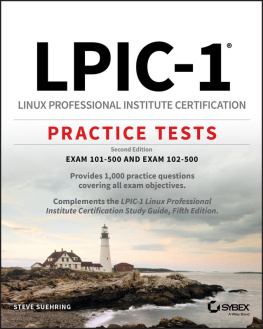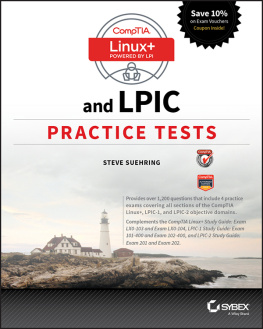Preface
Certification of professionals is a time-honored tradition in many fields, including medicine and law. As small computer systems and networks proliferated over the last decade, Novell and Microsoft produced extremely popular technical certification products for their respective operating system and network technologies. These two programs are often cited as having popularized a certification market for products that had previously been highly specialized and relatively rare. These programs have become so popular that a huge training and preparation industry has formed to service a constant stream of new certification candidates.
Certification programs, offered by vendors such as Sun and Hewlett-Packard, have existed in the Unix world for some time. However, since Solaris and HP-UX aren't commodity products, those programs don't draw the crowds that the PC platform does. Linux, however, is different. Linux is both a commodity operating system and is PC- based, and its popularity continues to grow at a rapid pace. As Linux deployment increases, so too does the demand for qualified and certified Linux system administrators.
A number of programs such as the Linux Professional Institute (LPI), the Red Hat Certified Engineer (RHCE) program, and CompTIA's Linux+ have formed over the last few years to service this new market. Each of these programs seek to provide objective measurements of a Linux administrator's skills, but they approach the problem in different ways.
The RHCE program requires that candidates pass multiple exam modules, including two hands-on and one written, whose goals are to certify individuals to use their brand of products. The Linux+ program requires a single exam and is focused at entry-level candidates with six months' experience. LPI's program is a job-based certification and currently consists of two levels that focus on two-year (Level 1) and four-year (Level 2) experienced candidates.
The Linux Professional Institute
The Linux Professional Institute (http://www.lpi.org) is a nonprofit organization formed with the single goal of providing a standard for vendor-neutral certification. This goal is being achieved by certifying Linux administrators through a modified open source development process. LPI seeks input from the public for its exam Objectives and questions, and anyone is welcome to participate. It has both paid and volunteer staff and receives funding from some major names in the computer industry. The result is a vendor-neutral, publicly developed program that is offered at a reasonable price.
LPI currently organizes its Linux Professional Institute Certification (LPIC).
LPI is in the process of building a third level of exams, which will focus on specialty fields. It is also working with other organizations to start building certification modules based on the LPI standard.
Level 1 is aimed at junior to midlevel Linux administrators with about two years of practical system administration experience. The Level 1 candidate should be comfortable with Linux at the command line as well as capable of performing simple tasks, including system installation and troubleshooting. Level 1 certification is required prior to obtaining Level 2 certification status.
Level 2 is for senior Linux system administrators and team leaders. A Level 2 administrator is likely to have four or more years of practical administration experience. Beyond the ability to work effectively with native tools on standard Linux distributions, Level 2 covers customizing all aspects of your Linux systems, from the kernel to its filesystems, as well as implementing a number of network applications for Linux servers. At a glance, Level 2 Objectives may appear to overlap several areas of content with Level 1; however, the depth and expertise level required is much higher. Often, a Level 2 candidate is expected to be the individual that a Level 1 candidate would refer to for higher-level projects or problems within a production environment.
Level 2 certification will be required prior to obtaining the future Level 3 certification status.
All of LPI's exams are based on a published set of technical Objectives. These technical Objectives are posted on LPI's web site and for your convenience printed at the beginning of each chapter within this book. Each Objective set forth by LPI is assigned a numeric weight, which acts as an indicator of the importance of the Objective. Weights run between 1 and 8, with higher numbers indicating more importance. An Objective carrying a weight of 1 can be considered relatively unimportant and isn't likely to be covered in much depth on the exam. Objectives with larger weights are sure to be covered on the exam, so you should study these closely. The weights of the Objectives are provided at the beginning of each chapter.
Audience for This Book
The primary audience for this book is, of course, candidates seeking the LPIC certification. These may range from administrators of other operating systems looking for a Linux certification to complement an MSCE certification to Unix administrators wary of a growing pool of Linux-certified job applicants. In any case, this book will help you with the specific information you require to be successful with both the Level 1 and Level 2 Exams. Don't be fooled, however, as book study will not be enough to pass your exams. Remember, practice makes perfect!
Due to the breadth of knowledge required by the LPI Objectives and the book's one-to-one coverage, it also makes an excellent reference for skills and methods required for the day-to-day use of Linux. If you have a basic working understanding of Linux administration, the material in this book will help fill gaps in your knowledge while at the same time preparing you for the LPI Exams, should you choose to take them.
This book should also prove to be a valuable introduction for new Linux users and administrators looking for a broad, detailed introduction to Linux. Part of the LPI exam-creation process includes a survey of Linux professionals in the field. The survey results drive much of the content found on the exams. Therefore, unlike general-purpose introductory Linux books, all of the information in this book applies directly to running Linux in the real world.
Organization
This book is designed to exactly follow the Topics and Objectives established by LPI for Levels 1 and 2. That means that the presentation doesn't look like any other Linux book you've read. Instead, you can directly track the LPI Objectives and easily measure your progress as you prepare.
The book is presented in four parts. to cover Exams 201 and 202 for LPI's Level 2 Exams. Each part contains chapters dedicated to the LPI Topics, and each of those sections contains information on all of the Objectives set forth for the Topic. In addition, each part contains a practice exam (with answers), review questions and exercises, and a handy highlighter's index that can help you review important details.
Book Chapters
Each part of this book contains some combination of the following materials:





